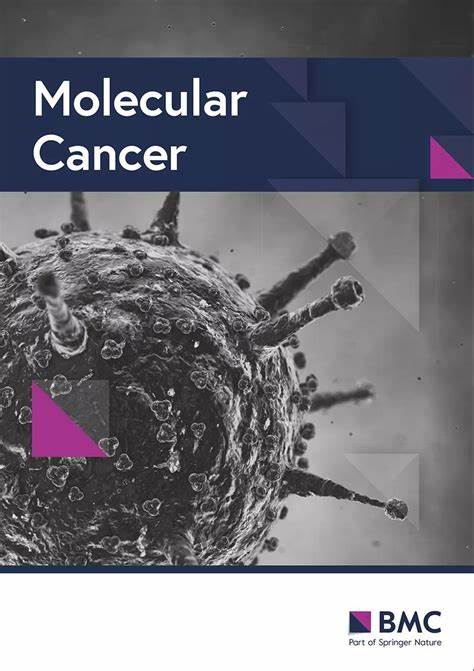Overcoming resistance to anti-PD-L1 immunotherapy: mechanisms, combination strategies, and future directions.
IF 33.9
1区 医学
Q1 BIOCHEMISTRY & MOLECULAR BIOLOGY
引用次数: 0
Abstract
Cancer cells express high levels of programmed cell death-ligand 1 (PD-L1) to evade immune surveillance. PD-L1 interacts with PD-1 on T cells to make them non-functional. Thus, PD-L1 and PD-1 are pivotal targets in cancer immunotherapy. While anti-PD-1/PD-L1 therapies have offered renewed hope for many patients, their modest efficacy remains a critical concern. This underscores the urgent need to unravel the intricate mechanisms that govern both therapeutic responses as well as resistance to immunotherapy. This review explores the multifaceted nature of PD-L1, including factors that regulate its expression, tumor-immune interactions, and the resistance mechanisms associated with anti-PD-L1 immunotherapy. Several promising strategies have been explored to overcome these challenges, such as combination therapies, modulation of the tumor microenvironment, neoantigen targeting, and dynamic biomarker monitoring. Outcomes of these approaches, integrating advanced technologies like high-resolution imaging, machine learning, multi-omics profiling, and liquid biopsy for soluble PD-L1 detection emerge as a powerful means to refine patient stratification. Together, these innovations pave the way toward more precise and personalized immunotherapy, maximizing clinical benefits for cancer patients. Additionally, the evolving landscape of clinical trials involving anti-PD-1/PD-L1 monoclonal antibodies has been explored, emphasizing the integration of immune checkpoint therapies with chemotherapy, radiotherapy, targeted therapy, CAR-T, and metabolic immunotherapy to overcome resistance in refractory cancers. By embarking on these challenges and leveraging novel therapeutic strategies, this review intends to advance the understanding of more effective, personalized cancer immunotherapies, ultimately improving outcomes for a broader range of patients.克服抗pd - l1免疫治疗的耐药性:机制、联合治疗策略和未来发展方向。
癌细胞表达高水平的程序性细胞死亡配体1 (PD-L1)以逃避免疫监视。PD-L1与T细胞上的PD-1相互作用,使T细胞失去功能。因此,PD-L1和PD-1是肿瘤免疫治疗的关键靶点。虽然抗pd -1/PD-L1疗法为许多患者带来了新的希望,但其适度的疗效仍然是一个关键问题。这强调了迫切需要解开控制治疗反应和免疫治疗耐药性的复杂机制。这篇综述探讨了PD-L1的多面性,包括调节其表达的因素、肿瘤免疫相互作用以及与抗PD-L1免疫治疗相关的耐药机制。为了克服这些挑战,已经探索了几种有希望的策略,如联合治疗、肿瘤微环境调节、新抗原靶向和动态生物标志物监测。这些方法的结果,整合了高分辨率成像、机器学习、多组学分析和可溶性PD-L1检测的液体活检等先进技术,成为完善患者分层的有力手段。总之,这些创新为更精确和个性化的免疫治疗铺平了道路,最大限度地提高了癌症患者的临床效益。此外,研究人员还探索了抗pd -1/PD-L1单克隆抗体临床试验的发展前景,强调了免疫检查点疗法与化疗、放疗、靶向治疗、CAR-T和代谢免疫疗法的结合,以克服难治性癌症的耐药性。通过应对这些挑战和利用新的治疗策略,本综述旨在促进对更有效、更个性化的癌症免疫疗法的理解,最终改善更广泛患者的治疗效果。
本文章由计算机程序翻译,如有差异,请以英文原文为准。
求助全文
约1分钟内获得全文
求助全文
来源期刊

Molecular Cancer
医学-生化与分子生物学
CiteScore
54.90
自引率
2.70%
发文量
224
审稿时长
2 months
期刊介绍:
Molecular Cancer is a platform that encourages the exchange of ideas and discoveries in the field of cancer research, particularly focusing on the molecular aspects. Our goal is to facilitate discussions and provide insights into various areas of cancer and related biomedical science. We welcome articles from basic, translational, and clinical research that contribute to the advancement of understanding, prevention, diagnosis, and treatment of cancer.
The scope of topics covered in Molecular Cancer is diverse and inclusive. These include, but are not limited to, cell and tumor biology, angiogenesis, utilizing animal models, understanding metastasis, exploring cancer antigens and the immune response, investigating cellular signaling and molecular biology, examining epidemiology, genetic and molecular profiling of cancer, identifying molecular targets, studying cancer stem cells, exploring DNA damage and repair mechanisms, analyzing cell cycle regulation, investigating apoptosis, exploring molecular virology, and evaluating vaccine and antibody-based cancer therapies.
Molecular Cancer serves as an important platform for sharing exciting discoveries in cancer-related research. It offers an unparalleled opportunity to communicate information to both specialists and the general public. The online presence of Molecular Cancer enables immediate publication of accepted articles and facilitates the presentation of large datasets and supplementary information. This ensures that new research is efficiently and rapidly disseminated to the scientific community.
 求助内容:
求助内容: 应助结果提醒方式:
应助结果提醒方式:


